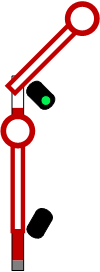
Usually semaphore signals are being phased out and replaced by colour light signals, but in 2001 I have seen a place where they even erected new wire-operated semaphores...

The simple semaphore signals can show "clear" or "stop". An additional aspect can show "slow", i.e. 40 km/h. Note that on signals that never show the slow aspect, the lower arm (as well as the amber light) is omitted. The white-red-white marking looks like a main signal post plate, but (as opposed to colour light signals) here it is simply a marking to enhance visibility and has no special meaning.
 |
 |
 |
| Hp 1: clear with line speed | Hp 2: slow (40 km/h) | Hp 0: stop |
The signals are also equipped with lanterns that are lit at
night, by gas lanterns in
the old days, now by solar-driven LED matrices.
These night aspects
(see below) were the prototype for
the aspects of the Hp colour light
signals.
Lower speeds other than 40 km/h may be indicated by the
Zusatzsignal (Subsidiary
signal) Zs 3
(signal) or Zs 3v (announcer).
Distant signals indicate which aspect is to be expected at the next main signal. The distant signal carries a yellow disc with a black/white border. If the main signal shows "clear", the disc is flipped edge-on (so it is virtually invisible).
In case that the main signal is capable of showing the "slow" aspect, the distant signal additionally bears a yellow arrow-shaped arm with a white/black border.
DR distant signals are a little different from DB
signals:
The arm (where present) may be white with a red border, although
to my knowledge by now all have been repainted to the standard colouring.
Also the distant signal aspects Vr 1 and Vr 0 may
display only the upper right
light (green or amber), except when the distant signal is mounted at
the same post as or
close to a main signal.
The aspect Vr 2 has the green and amber lanterns switched, to
avoid confusion with
the Hl 3a aspect.
 |
 |
 |
 |
 |
| Vr 1: expect clear | Vr 2: expect slow | Vr 0: caution (expect stop) | Vr 2 (DR variant) | Vr 2 (obsolete, DR variant. The red-white arm should have been replaced by now) |
The rectangular sign at the signal's post is the distant signal post plate. The plate makes sure that the signal will be clearly visible when the disc is flipped edge-on.
| When the distant signal is mounted overhead, e.g. is suspended from a gantry, the arm is usually mounted above the disc. |
 |
The distant signal is announced by three approach markers (where necessary there may be up to five markers, but this is rare).
If the distant signal is located in a reduced distance to the
corresponding main
signal, on DB lines a small white triangle with a black border pointing
downwards is
mounted on top of the distant signal sign, and as well on the first
(three-stripe) approach
marker.
On DR lines there is no triangle but a circle at the "X" intersection
in the
distant signal board.
See also the post plates page.
Where needed, distant signals may be repeated. These distant signal repeaters are always colour light type, even when distant and/or main signal are semaphores. On DB lines, this repeater will be of Hp type, on DR lines, the Hl type is used.
 |
 |
 |
 |
 |
| distant signal approach markers | distant signal post plate (DB) main signal is at reduced distance | distant signal post plate (DR) main signal is at reduced distance | ||
 |
 |
 |
 |
 |
 |
 |
| Hp 1 | Hp 2 | Hp 0 | Vr 1 | Vr 2 | Vr 2 (DR) | Vr 0 |
Note that in former versions of the signal book, there were cases when the night aspects should be visible from rear. This is obsolete now, and more and more semaphores (especially when the gas lanterns or bulbs have been replaced by LEDs) are found without rear lights. Where red or blanked, lanterns show full white light backwards, and green or amber lanterns show a small white light (Sternlicht/star light). Signals that have just one arm obviously have only one rear light (i.e. one small light: clear, one full light: stop).
Note also that a distant signal always shows two full lights, regardless of the aspect.
| Hp 1 | Hp 2 | Hp 0 | Vr 1 | Vr 2 | Vr 0 |
 |
 |
 |
 |
||
| Rear aspects | Rear aspect | ||||
 home home |
 home &
distant signals home &
distant signals |
 email email |
 Hp signals Hp signals |